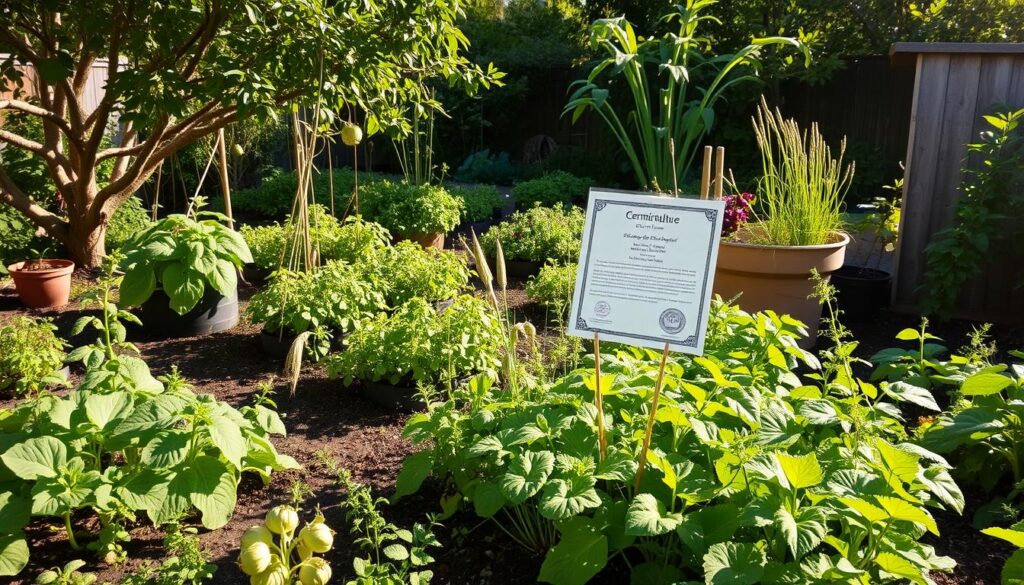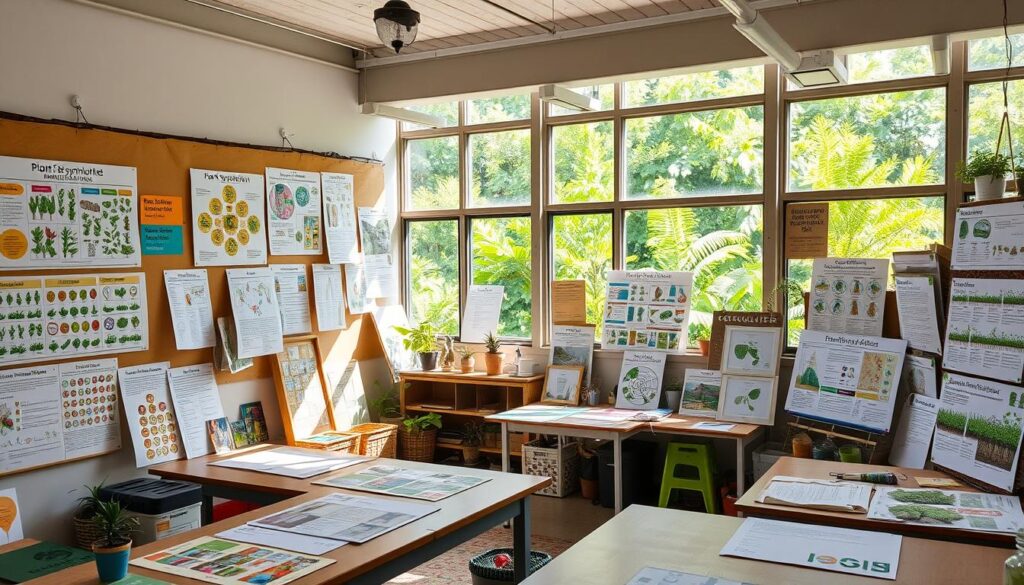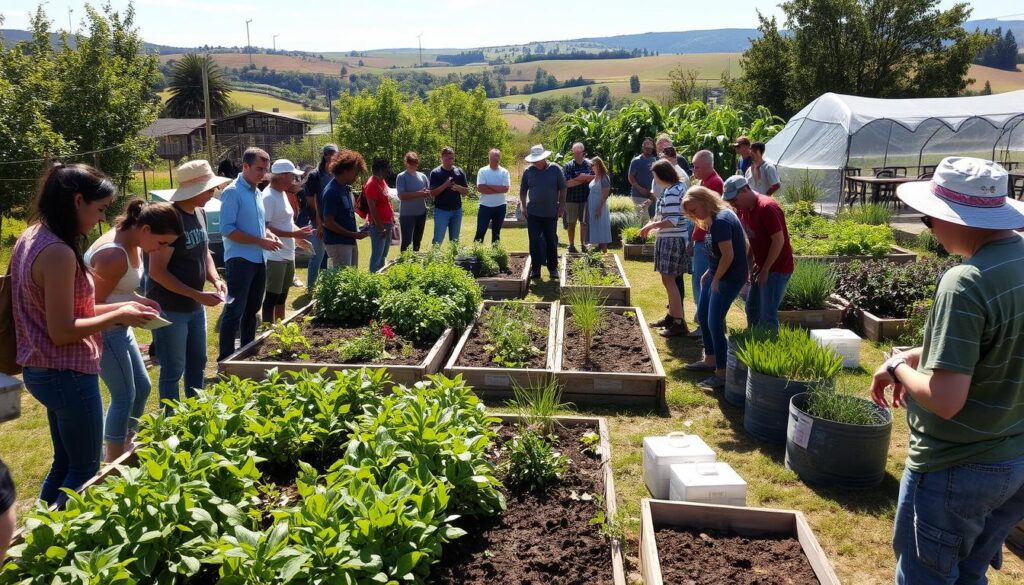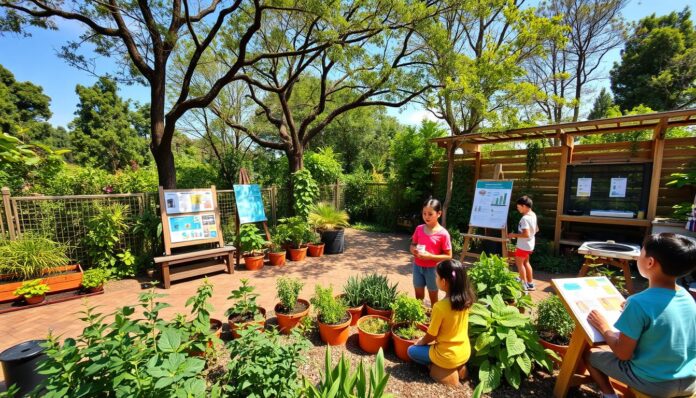Creating a sustainable future is a big task. It requires the right educational resources for permaculture. Teachers play a key role in teaching students about living sustainably and environmental programs. With over 125,000 subscribers on the Permaculture Life YouTube channel, and more than 2,500 registrants for the first International Permaculture Festival of Ideas, the interest in permaculture education is growing.
The Permaculture Education Institute offers courses like the Permaculture Design Certificate and Permaculture Teacher Certificate. These courses help teachers provide quality education in sustainable living and environmental programs. As more people seek permaculture education, it’s important to know the key topics and resources. This article will cover permaculture educational resources, sustainable living education, and environmental education programs.
Key Takeaways
- Permaculture educational resources are crucial for teachers to educate students about sustainable living and environmental education programs.
- The Permaculture Education Institute offers various courses and resources for permaculture teachers.
- There is a growing demand for permaculture educational resources, with over 125,000 subscribers on the Permaculture Life YouTube channel.
- Permaculture teachers can benefit from the Permaculture Design Certificate and Permaculture Teacher Certificate.
- Environmental education programs and sustainable living education are essential components of permaculture education.
- Permaculture educational resources can support teachers in providing high-quality education and promoting sustainable living.
Understanding Permaculture Principles
Permaculture is a way to design sustainable living systems. It focuses on caring for the earth and people. Eco-friendly learning materials and permaculture courses online help learn these principles.
The ethics of permaculture are key. They include caring for the earth, people, and sharing fairly. Regenerative agriculture workshops offer hands-on learning in permaculture.
The Ethics of Permaculture
The ethics of permaculture are simple yet powerful. They are about caring for the earth, people, and sharing fairly. These principles guide us in creating sustainable systems.
Core Design Principles
Permaculture’s core principles are about observing nature and working with it. They include catching and storing energy and getting a yield. These principles help us design efficient and sustainable systems.
Importance of Sustainability
Sustainability is at the heart of permaculture. It helps us reduce our environmental impact. Permaculture courses online and regenerative agriculture workshops teach us how to design sustainably.
| Permaculture Principle | Description |
|---|---|
| Earth Care | Caring for the earth and all living things |
| People Care | Caring for people and their well-being |
| Fair Share | Sharing resources and benefits fairly |
Key Permaculture Texts
For those interested in permaculture, several key texts offer valuable insights. These texts range from introductory guides to in-depth manuals. By using organic gardening tutorials and green living resources, educators can help students understand environmental education programs better.
“Permaculture: A Designer’s Manual” by Bill Mollison, “The Permaculture Handbook” by Peter Bane, and “Gaia’s Garden” by Toby Hemenway are notable texts. They give a detailed look at permaculture principles and practices. These books are great for both teachers and students.

The table below shows some key permaculture texts and their focus areas:
| Text | Author | Focus Area |
|---|---|---|
| Permaculture: A Designer’s Manual | Bill Mollison | Comprehensive permaculture guide |
| The Permaculture Handbook | Peter Bane | Practical permaculture applications |
| Gaia’s Garden | Toby Hemenway | Home-scale permaculture |
Exploring these key permaculture texts helps students understand environmental education programs better. It also promotes sustainable living practices.
Online Permaculture Courses
Online learning platforms have made permaculture education more accessible. Now, you can learn about sustainable living from home. This is thanks to a wide range of permaculture courses online.
The Permaculture Women’s Guild is a great place to start. They offer online courses and recommend providers like the Permaculture Education Institute. These providers have courses for all levels, from beginners to advanced certifications.
Recommended Course Providers
- Permaculture Education Institute
- Permaculture Women’s Guild
- Regenerative Leadership Institute
These online courses are affordable and open to many learners. Some offer scholarships or payment plans. This makes learning permaculture easier for everyone.
Cost and Accessibility
Online permaculture courses let you learn from experts and connect with others worldwide. They’re perfect for both newbies and experienced permaculture enthusiasts. So, there’s a course for everyone.
| Course Provider | Course Name | Cost |
|---|---|---|
| Permaculture Education Institute | Introduction to Permaculture | $200 |
| Permaculture Women’s Guild | Permaculture Design Certification | $1,000 |
| Regenerative Leadership Institute | Regenerative Leadership | $500 |
Permaculture Design Certifications
Permaculture design certifications are key for those eager to dive deep into regenerative agriculture and eco-friendly learning. The Permaculture Design Course (PDC) is a detailed program. It teaches students how to build sustainable, eco-friendly systems.
Overview of Permaculture Design Course (PDC)
The PDC is a 72-hour course that dives into permaculture’s core principles. It includes regenerative agriculture workshops and eco-friendly learning materials. It’s backed by the Permaculture Institute of N. America (PINA) and is known worldwide.
Benefits of Certification
Getting certified offers many perks. You’ll gain more knowledge and skills in permaculture design. It also opens up better job chances in environmental education programs.
You’ll meet other permaculture experts and join a global community of practitioners.
Finding Accredited Programs
To find accredited programs, check the Permaculture Education Institute website. Look for programs endorsed by the Permaculture Institute of N. America (PINA). The Permaculture Practice website also lists permaculture design courses and workshops.

| Program | Duration | Cost |
|---|---|---|
| Permaculture Design Course (PDC) | 6 months | $1,000 – $2,000 |
| Regenerative Agriculture Workshops | 1-3 days | $100 – $500 |
Teaching Techniques for Permaculture
Good permaculture teaching means hands-on learning, using local nature, and making lessons fun. The Permaculture Women’s Guild says these methods are key. With online courses and gardening tutorials, teachers can teach students about living green.
Some important teaching methods for permaculture are:
- Hands-on learning approaches, such as workshops and community projects
- Utilizing local ecosystems, such as gardens and natural areas
- Creating engaging curriculum, such as games and activities
These methods work well with online courses and gardening tutorials. They give a full education in permaculture.
Teachers using these methods help students get permaculture. They learn about sustainable living and green resources.
| Technique | Description |
|---|---|
| Hands-on learning | Workshops, community projects, and other interactive activities |
| Utilizing local ecosystems | Gardens, natural areas, and other local environments |
| Creating engaging curriculum | Games, activities, and other interactive educational materials |
Utilizing Multimedia Resources
Teaching students about sustainable living and environmental education is key. The Permaculture Education Institute suggests using multimedia to do this. This includes documentaries, podcasts, and YouTube channels that share valuable permaculture insights.
Teachers can make lessons fun and interactive by adding these resources. For instance, documentaries can show permaculture projects. Podcasts can dive deep into permaculture topics.
Documentaries and Films
Documentaries are great for introducing permaculture to students. “The Biggest Little Farm” and “Kiss the Ground” are examples. They focus on sustainable agriculture and caring for the environment.
Podcasts and Audio Resources
Podcasts are also a great tool for permaculture education. Shows like “The Permaculture Podcast” and “The Sustainable Living Podcast” cover many topics. They offer discussions on permaculture and living sustainably.
YouTube Channels for Learning
YouTube channels like “Geoff Lawton’s Permaculture” and “Permaculture Research Institute” are full of useful info. They have video tutorials, workshops, and lectures. These can enhance classroom learning.

Using these multimedia resources, teachers can create a rich permaculture education program. It promotes sustainable living and environmental awareness. These tools help students understand permaculture better and inspire them to help create a sustainable future.
Case Studies in Permaculture
The Permaculture Women’s Guild shares success stories from real permaculture projects. These stories show how permaculture helps local communities. They highlight the role of regenerative agriculture workshops and eco-friendly learning materials in promoting green living resources.
Some notable case studies include:
- Successful permaculture projects in schools, kindergartens, and organic farms
- Permaculture parenting practices and community-based initiatives
- Projects featuring diverse settings and experiences from different countries
These stories prove permaculture works in many places. They give insights to educators, farmers, and leaders. By using regenerative agriculture workshops and eco-friendly learning materials, we can help make the future greener.

| Case Study | Location | Outcome |
|---|---|---|
| Permaculture in Schools | Europe | Increased student engagement and environmental awareness |
| Organic Farming | United States | Improved crop yields and reduced environmental impact |
| Community-based Initiative | Australia | Enhanced community cohesion and environmental sustainability |
Networking and Community Building
Building a strong network and community is key for permaculture education. Joining permaculture associations and attending workshops helps teachers learn a lot. They can share this knowledge with students through online courses and tutorials.
Outreach, fundraising, and dialogue are important for building a community. These skills help create a sense of belonging. When everyone helps design and build, they feel more connected to the project.
Online permaculture courses give teachers the tools to teach about the environment. Organic gardening tutorials are also great for teaching sustainable gardening. By using these resources, teachers can inspire a sustainable community.
Community building in permaculture education has many benefits. It leads to a stronger sense of community and better knowledge in permaculture. It also improves environmental education and makes people feel more connected to projects.
- Increased sense of community and social connection
- Improved knowledge and skills in permaculture and sustainable gardening
- Enhanced environmental education programs
- Greater sense of ownership and connection to community projects
Permaculture in Schools
Adding permaculture to K-12 education is key for a green future. Schools can use permaculture resources to teach students about living sustainably. The Permaculture Women’s Guild helps by offering lesson plans and materials.
Renuable Kids is a great example. It teaches kids about being green by reducing waste and making eco-friendly choices. Kids learn through fun projects and hands-on activities. This way, they get to see how nature works and create their own green spaces.
- Developing life skills such as responsibility and teamwork through gardening activities
- Encouraging mindfulness practices like meditation and yoga to manage stress and improve focus
- Instilling values of sustainability, mindfulness, and holistic living to prepare students for adulthood
By using permaculture in schools, teachers can teach students about living green. This helps students understand the importance of taking care of our planet. It also prepares them to live sustainably as adults.
Integrating permaculture in schools is vital for a greener future. It gives teachers the tools to teach students about the environment. This way, students can grow up to make a difference for our planet.
| Program | Focus | Benefits |
|---|---|---|
| Renuable Kids | Sustainability and permaculture | Develops life skills, encourages mindfulness, and instills values of sustainability |
Advocacy and Awareness
The Permaculture Education Institute stresses the need for advocacy and awareness in permaculture education. It promotes permaculture in local communities. This helps spread the word about the good of regenerative agriculture workshops and eco-friendly learning materials.
Environmental education programs are key. They focus on sustainable practices and getting the community involved. This way, people learn about the importance of taking care of our planet.
To promote permaculture, you can start by organizing workshops and events. These can show the benefits of regenerative agriculture and eco-friendly learning. For instance, starting a community garden can be a great way to apply permaculture principles in real life.
Working with local schools and organizations is also a good idea. It helps add environmental education to school curricula. This way, more people learn about sustainable practices.
Creating awareness campaigns is another effective strategy. Use social media, local newspapers, and community events to spread the word. By reaching out to policy makers and community leaders, you can create a supportive environment for permaculture.
Some key strategies for promoting permaculture and environmental education include:
- Building partnerships with local organizations and schools
- Organizing community events and workshops
- Creating awareness campaigns through social media and local media
- Engaging policy makers and community leaders
Online Permaculture Communities
Online permaculture courses and organic gardening tutorials have changed the game. They let educators easily find green living resources and meet others who share their interests. The Permaculture Women’s Guild, for example, offers online communities. These include forums and social media groups where educators can share and work together.
These online spaces are full of valuable information and support. They cover everything from permaculture design to sustainable living. By joining these communities, educators can learn more and connect with others in the field. This helps them improve their teaching and spread the word about green living.
- Access to a wide range of permaculture courses online and organic gardening tutorials
- Opportunities for collaboration and knowledge-sharing with other educators
- Support and guidance from experienced permaculture practitioners
By using these online communities and resources, educators can make lessons that teach green living and sustainability. This inspires a new generation of permaculture fans.
Skills Development for Teachers
Permaculture educational resources are key for teachers to learn about sustainable living and environmental education. The Permaculture Education Institute offers workshops and skill-building events. These help teachers improve their knowledge and skills in permaculture.
This way, teachers can create engaging lessons for their students. It’s a great way to teach about sustainable living.
Some important skills for permaculture teachers include:
- Workshops and skill-building events to enhance teaching skills
- Continued education opportunities to stay updated on the latest permaculture practices
- Resources for professional development, such as online courses and mentoring programs
By investing in skills development, teachers can inspire their students to live sustainably. This is crucial as the need for permaculture skills grows. Teachers need to keep learning to promote sustainable living education.
Research and Data in Permaculture
Permaculture research and data are key to understanding the field’s trends and best practices. The Permaculture Women’s Guild offers valuable insights and data. This helps in creating effective regenerative agriculture workshops and eco-friendly learning materials.
Important resources include David Holmgren’s “Permaculture Principles and Pathways Beyond Sustainability” in 16 languages. The “Food Plants International” website also has a vast database of edible food plants, with over 30,000 entries.
These resources support green living and sustainable practices. Educators can use this data to create strong curricula and materials. This promotes teaching permaculture principles and practices effectively.
- The Permaculture Design Certificate (PDC) Course has a total course duration of 72 hours.
- The course has an impressive average student rating of 4.9 stars.
- Live review sessions via Zoom occur four times per year over a period of 9 weeks.
These statistics show the success of permaculture education. By adding regenerative agriculture workshops and eco-friendly materials, we can support a sustainable future.
| Resource | Description |
|---|---|
| Permaculture Women’s Guild | Provides research and data on permaculture, including current trends and data sources. |
| Food Plants International | Hosts the world’s largest database of edible food plants, containing information on over 30,000 food plants. |
Future of Permaculture Education
The need for green practices is on the rise. Permaculture courses online and organic gardening tutorials are getting easier to find. This lets teachers add these lessons to their environmental education.
New teaching methods are key to better permaculture education. Hands-on learning and using new tech are important. Online courses and interactive tutorials can reach more people and offer tailored learning.
There’s also a big push for sustainability and fighting climate change. This will lead to more detailed and wide-ranging permaculture courses. Teachers will use the latest research to teach students how to face big environmental problems.

